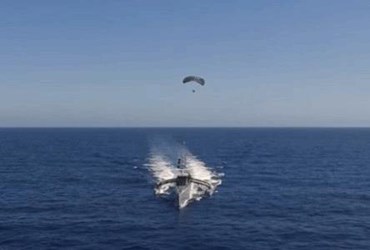DARPA's Parasailing Radar Extends Radio Range Of U.S. Navy's Drone Ships
By Jof Enriquez,
Follow me on Twitter @jofenriq

The Defense Advanced Research Projects Agency (DARPA) has completed the initial demonstration of its parasailing radar system designed to be deployed and towed behind naval ships to extend their long-distance communications range.
DARPA envisions future naval warfare to involve futuristic drone vessels – such as its experimental Anti-Submarine Warfare Continuous Trail Unmanned Vessel (ACTUV) – patrolling hostile waters for long periods of time, while manned boats remain out of harm’s way, notes Technology Review.
ACTUV itself is being tested as a platform for other experimental subsystems, one of which is the Towed Airborne Lift of Naval Systems (TALONS) project. TALONS attempts to build a low-cost, automated, parachute-like airfoil system towed behind ships — which could carry intelligence, surveillance, and reconnaissance (ISR), and communications payloads of up to 150 pounds — to an altitude of between 500-1,500 feet above sea level, much greater than the height of ships' onboard masts.
At 50 feet, line of sight is just eight miles, explains The War Zone, but with TALONS aloft, peering down from 1,500 feet, the line of sight to the horizon is nearly 50 miles in any direction.
Prototype testing progressed rapidly, from land-based testing in Arizona (June 2014) to field testing (between May and June 2015) in the waters off Maryland and Virginia, under different wind conditions for both hand-deployed and mast-deployed platforms. The latest demonstration took place over two days with 90 minutes of flight each day.
As described by DARPA: "The TALONS prototype started out from its “nest” installed on the back of the ACTUV vehicle. It then expanded its parachute and rose to an altitude of 1,000 feet, where it tested its onboard sensors and communications equipment. Once the test was complete, the prototype reeled itself in back to the nest. The entire process took place as the ACTUV vehicle maneuvered at operationally realistic speeds."
DARPA said the airborne TALONS parachute extended the ACTUV vessel's surface radar by six times compared to its range at sea level, doubled the observed discrimination range of its electro-optical/infrared scanner, and tripled the range of an onboard commercial handheld omnidirectional radio.
“This ACTUV/TALONS demonstration is the latest in DARPA’s history of cross-program collaboration to develop breakthrough technologies for national security,” said Brad Tousley, director of DARPA’s Tactical Technology Office (TTO), which oversees both ACTUV and TALONS. “Where it’s a good fit, joint testing provides the opportunity to show the robustness and interoperability of each program’s research, as well to explore potential future uses that wouldn’t be evident by testing each program separately.”
DARPA is transitioning the TALONS program over to the United States Navy for further development and testing. It could be deployed in the near future, as the technology could work with smaller or conventional boats as well as more advanced ocean-going unmanned surface vessels (USVs) like the ACTUV sub-hunting ship.
The ACTUV program will take a little longer – it's slated for transition to the U.S. Navy by 2018, pending results of an extended test phase to be conducted jointly by DARPA and the Navy's Office of Naval Research (ONR).
